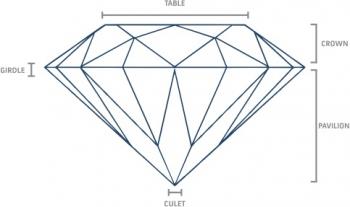radhekrishnaimpex2018@gmail.com 08069247355 Ext : 784
- Send SMS Send Email
4C'S Diamond

The Four C's stand for Cut, Color, Clarity, and Carat Weight . The diamond grading system has transformed the diamond trade and today is used by nearly every professional in the industry and diamond enthusiasts across the globe. Because individual diamond varies so immensely in quality and price, it is vital for consumers to be familiar with the Four C's as well. We've outlined the basics of this grading system below, to help give consumers the resources they need to make educated purchases.
The 4Cs of a diamond are the most important factors that play a critical role in determining the price of a diamond. These include diamond carat weight, diamond color, diamond clarity, and diamond cut. While the first three a natural elements, the fourth one depends on the quality of the craftsmanship, so cut is a human factor.
It is very important to note that you would have to learn more about each C in order to understand how important that C is while considering a diamond. Please also note that there could be a big difference between a diamond that has the same grading in terms of the C4s, so understanding the details of each C is important.
4Cs of Diamonds CUT| Cut of DIAMONDS
The diamond cut is the most important element to consider when buying a diamond. The cut is the biggest factor in creating sparkle and fire, and without a high cut grade even a diamond of high quality can appear dull and lifeless. A diamond cut poorly and too deep can face-up smaller than it actually is. A well-cut diamond will direct more light through the crown. A diamond with a depth that's too shallow or too deep will allow light to escape through the sides or the bottom of the stone.
A diamond’s clarity, colour and carat weight cannot be altered, but it is a high quality cut of diamond that can release that extra special sparkle
A diamond’s cut grade is the only factor that is influenced by a human hand. A master cutter will apprentice for at least 10 years before touching a 1 carat diamond. These highly-skilled craftsmen bring the ultimate beauty of the diamond to life by adhering to specific parameters in order to maximize sparkle. Several individual factors are evaluated to determine the cut grade of a diamond including its proportions, depth, symmetry, polish and finish.
The GIA uses the following scale to grade round brilliant diamonds:
- EXCELLENT An excellent cut diamond has a maximum amount of scintillation, brilliance and fire. Light enters the diamond and refracts back out with very little light lost. This exceptional grade represents roughly the top three-percent of diamonds.
- VERY GOOD A diamond with a very good cut grade will reflect most of the light and will appear somewhat similar to an ideal cut diamond. This diamond will have superior sparkle, brilliance and fire.
- GOOD Reflecting most of the light entering the diamond, this diamond cut has above average beauty. Diamonds with this grade won’t have as much brilliance and fire as higher cuts.
- FAIR Diamonds graded Fair don’t have the optimum brilliance and fire, as they allow a significant amount of the entering light to exit on the bottom or side of the diamond instead of through the top. These are still quality, but not nearly as well performing as a finer cut.
- POOR Diamonds with a poor cut may appear dull because the majority of the light is lost through the bottom or sides of the diamond. With a noticeable decrease in sparkle, even an untrained eye can see a sharp difference between this and higher cuts.

4Cs of Diamonds CLARITY
This refers to the inclusions (internal) or blemishes (external) held by the stone. A diamond`s clarity is determined under a 10x loupe magnification with the highest grading called Flawless which has no internal or external flaws. Flawless and Internally Flawless diamonds are incredibly rare. We then enter the realms of VVS, VS, SI and I which all include variations of the word imperfect such as very very slightly imperfect, very slightly imperfect, slightly imperfect and imperfect.
The Diamond Clarity Scale is segmented into six categories:
- Flawless (FL) A diamond that is graded as Flawless contains no inclusions or blemishes apparent to the grader under magnification.
- Internally Flawless (IF) These diamonds do not contain any inclusions but may contain a very small blemish under magnification.
- Very, Very Slightly Included (VVS1, VVS2) These diamonds may contain inclusions so minute that they are barely visible, even to the trained grader under magnification.
- Very Slightly Included (VS1, VS2) These diamonds contain minor inclusions not visible to the naked eye, but are apparent under magnification
- Slightly Included (SI1, SI2) These diamonds contain inclusions that are visible under magnification, and can occasionally be visible to the naked eye under close inspection.
- Included (I1, I2, I3) These diamonds contain noticeable inclusions that are almost always visible to the naked eye.

COLOR
Diamonds are graded in colour from D to Z, the scale begins with D (colourless) and finishes at Z (light yellow or brown), a diamond of a light yellow or a brown colour. A colourless stone will allow the maximum amount of light to travel through increasing its brilliance and fire so therefore the whiter a diamond the higher its price.
The Gemological Institute of America (GIA) grades diamond color on a scale of D to Z. D to Z diamonds are also known as white diamonds, even though most diamonds, including H color diamonds and G color diamonds, have varying amounts of color.
It's very difficult to tell the difference from one color grade to another color grade. That's why it's important to compare diamonds side by side. Colorless is the most rare and therefore the most expensive. Yellow is the least rare and therefore the least expensive.
Fancy Colored Diamonds
Fancy colored diamonds are not graded on the same scale as colorless diamonds and are rarer, making them more valuable and expensive.

CARAT
Diamond carat is often misunderstood and refers to a diamond's weight, not necessarily its size. When comparing diamond carat sizes, take a diamond's cut into consideration as well: a high-carat diamond with a poor cut grade may look smaller, often cut deeper, than a diamond with smaller carat weight and a better cut.

Size Chart

Contact Us
Radhe Krishna Impex
No. 301, Shivanjali Complex, Pipals Char Rasta, Pal, Surat, Gujarat - 395006, India
Mobile : +91-9558253684
Call Us : 08069247355 Ext : 784
E-mail : radhekrishnaimpex2018@gmail.com

